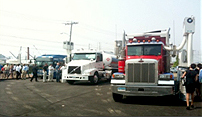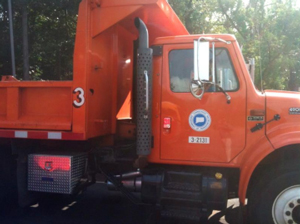Heavy Duty Vehicles

Heavy duty vehicles are a critical component of Connecticut's economy. School buses transporting students, ferries shuttling people across Long Island Sound, and planes, trucks and trains moving freight and consumer products across the state are a few examples of how important heavy duty vehicles are to Connecticut.
These heavy duty vehicles consume large amounts of fossil fuels. For the state to meet its clean air goals, we must take and support actions to optimize the efficiency of these heavy duty vehicle activities.
Connecticut's Freight Strategy

In 2013, DEEP commissioned a study to analyze and develop a strategy to reduce emissions from freight movement in the state. The report addresses how freight is moved in Connecticut, the emissions associated with freight movement now and in the future, and the most promising strategies to reduce the energy and environmental impacts of freight movement.
Development of a Strategic Plan for Reducing Emissions Associated with Freight Movement in Connecticut – March 28, 2013
SmartWay®

In 2015, DEEP became a SmartWay Affiliate. DEEP supports the goals of SmartWay and encourages you to explore the benefits of joining SmartWay.
EPA's SmartWay program helps companies advance supply chain sustainability by measuring, benchmarking, and improving freight transportation efficiency. This is accomplished by using market-based incentives and technology solutions to address long-term trends, changes and challenges in the freight transportation sector.
Find out more about SmartWay and learn how joining SmartWay can benefit your operations.
How can heavy duty vehicle emissions be reduced?
Retrofit Technologies
Retrofit technologies are products that can be installed on heavy duty engines to reduce pollution from vehicles that are typically powered by diesel fuel. The most commonly referenced retrofit technologies are diesel oxidation catalysts (DOCs), which function like catalytic converters in automobiles, and diesel particulate filters (DPFs).
EPA provides a substantial list of verified technologies that save fuel and reduce emissions.
Idle Reduction Technologies

Idle reduction technologies provide vehicles such as heavy duty trucks power for heating, cooling, and electricity without requiring the idling of the main engine. Idle reduction technologies can reduce air pollution at rest areas, truck stops, pick-up and delivery locations, ports and in other places where trucks idle for extended periods either for rest or in queues. Auxiliary power units (APUs) and truck stop electrification (TSE) are some of the ways idling can be reduced.
In addition, Connecticut has strict laws limiting the time a vehicle can idle. Find out more about our idling law on our anti-idling webpage.
Repower, Repair, Rebuild, or Replace
As heavy duty engines age, they become less efficient and more costly to maintain. A decision to repair, replace, or rebuild an engine is a difficult one to make, but federal and state funding programs like the Diesel Emissions Reduction Act (DERA) and Connecticut's VW Diesel Emissions Reduction Program are available to make this decision easier.
Maintenance and Cleaner Fuels
The simplest way to minimize emissions from heavy duty vehicles is to ensure they are properly maintained. This optimizes fuel economy and life of the engine. Emissions can be further reduced by operating on ultra-low sulfur fuel or biodisel blends if the engine is capable of utilizing these fuels.
Connecticut's Heavy Duty Emissions Reduction Projects

DEEP’s funding efforts since 2008 have leveraged millions from the state and national DERA, the Federal American Recovery and Reinvestment Act (aka Stimulus Act) and the Connecticut Clean School Bus Act to reduce heavy duty diesel emissions that impact both the environment and residents of the state.
Explore the history of our efforts and wide range of projects funded on our diesel emissions reduction project archive.
Content last updated February 3, 2020

